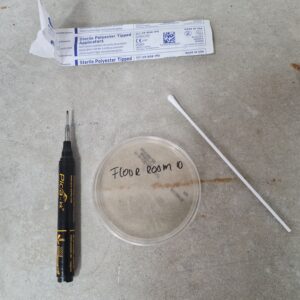I’m often asked where spores of mould suddenly appear from. In cases of one-off infections or clear sources of contamination the answer is easy. This only becomes an issue if the infection persists. At this moment the hygiene protocols are tightened. Strict hygiene should in fact always be a priority, but when there are just a few or no outbreaks of infections, the protocols tend to be relaxed. However, say that despite properly applying the hygiene protocols an infection just keeps on coming back. In this case it’s like looking for a needle in a haystack.
Forget it – spores are so small they are invisible to the naked eye. So how can we trace the culprit? To identify the cause it’s handy to have a way of being able to ‘see’ signs of spores. A proven method is swabbing. And you don’t have to be a lab technician to take a swab sample yourself.
You need the following materials: a sterile cotton bud, which you can buy at your local chemist or on the internet. Every knows what they look like since we started doing Covid tests. You will also need some petri dishes filled with a growth medium, the growth medium consists of MEA, with some antibiotics. Ask your spawn supplier if they can supply it. You also need an indelible marker and some tape. Take these materials to a place you expect, or want to know whether, it is clean or not. For example a concrete floor, door handles, reused crates, mushroom knife blades, clothing.
Remove the sterile cotton bud from the packaging. Place the tip of the cotton bud on the surface you want to sample. Wipe the cotton bud in a rotating movement across the surface of the object so it is covered in ‘dirty material’.
Then take the petri dish with the growth medium. Rub the tip of the bud across the surface of the growth medium that has been divided into four quadrants in the petri dish. This streaking transfers any spores you have captured onto the growth medium. Use the tape to seal the petri dish and write where the sample was taken on the tape with the indelible marker.
Store the petri dish at room temperature. You should see whether any mould spores have developed after 4-6 days!
Any growth is often aspergillus or penicillium. These are harmless moulds, but importantly they are proof that the object wasn’t clean!! These means that dry bubble or cobweb spores could also be present. If nothing develops at all, the object was really clean.
The disadvantage of this system is that the surface you want swab must be dry, otherwise bacteria will grow faster than spores which does not produce a good result. However, if you want to check whether water is contaminated, let the filter dry, and take a swab sample from the filter.
If this tip was interesting and you’d like more tips, take part in one of our training courses!
Mark den Ouden|Mushroom Blog

Copyright © 2024 – All rights reserved
This website uses cookies to ensure you get the best experience on our website.